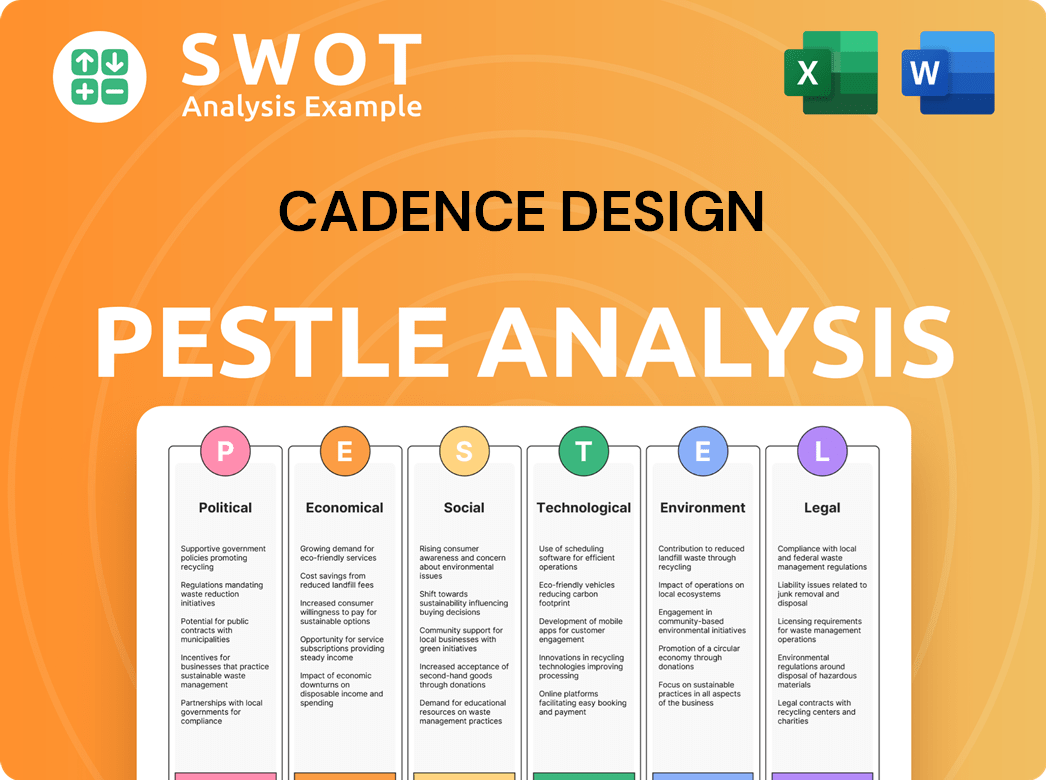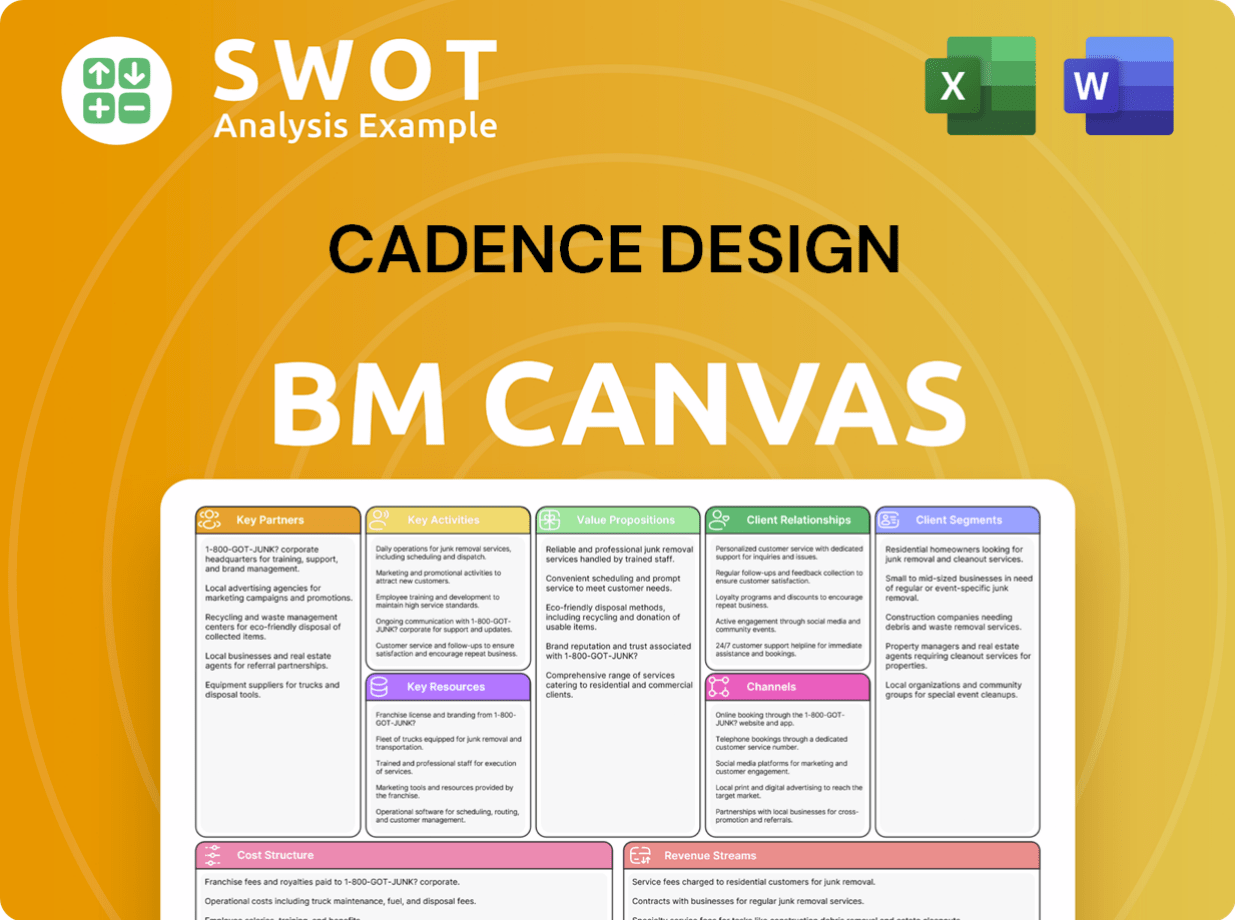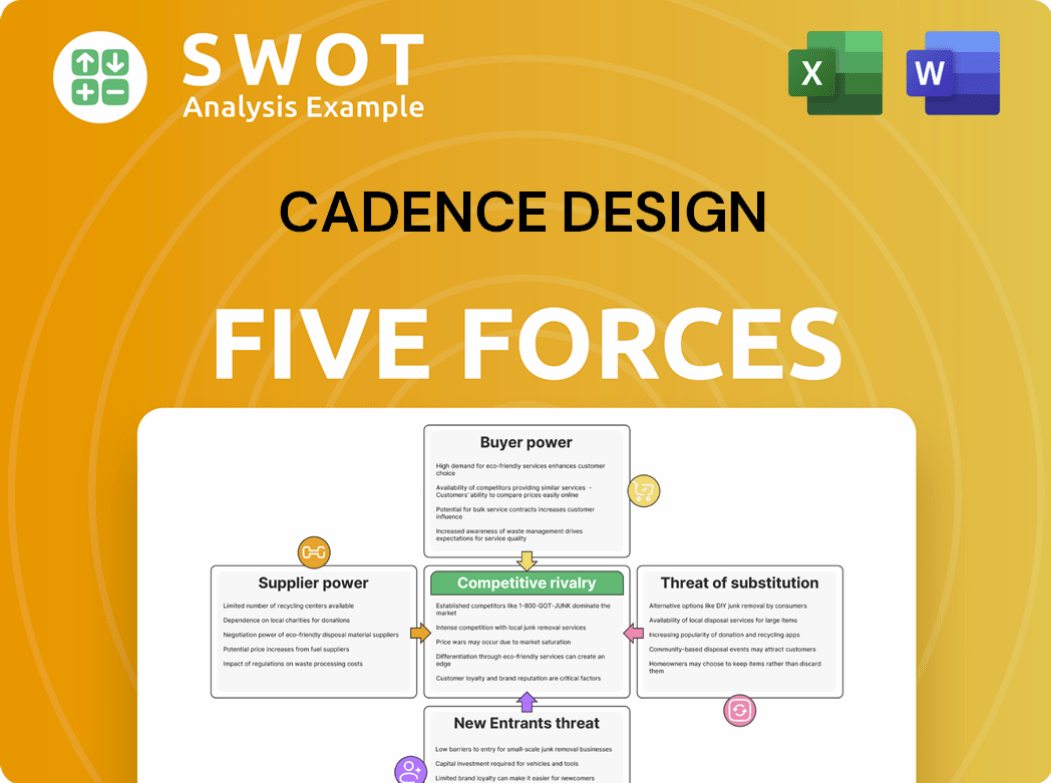Cadence Design Bundle
Who are Cadence Design Systems' Key Customers?
In the fast-paced world of semiconductors, understanding the Cadence Design SWOT Analysis is crucial. The rise of AI and ML has dramatically reshaped the electronic design automation (EDA) landscape, making a deep dive into customer demographics essential. This shift demands a comprehensive look at Cadence Design Systems' target market and its evolving needs.

Cadence Design Systems' customer profile has expanded significantly since its inception, moving beyond traditional IC design houses. This evolution necessitates a detailed target market analysis to understand who uses Cadence software and their specific requirements. Exploring the demographics of Cadence users reveals the company's broad industry focus and how it strategically addresses customer needs across various market segments. Understanding Cadence Design Systems' customer base size and geographical reach is key to evaluating its market share and the effectiveness of its sales strategy.
Who Are Cadence Design’s Main Customers?
Understanding the customer demographics and target market of Cadence Design Systems is crucial for grasping its business model. The company operates in the electronic design automation (EDA) software industry, serving a specialized business-to-business (B2B) market. Cadence's primary focus is on providing tools and services to companies involved in designing and manufacturing electronic systems.
The company's target market analysis reveals a concentration on the semiconductor and electronics systems industries. These sectors rely heavily on Cadence's EDA software for various design and verification processes. Cadence's customer base size includes a mix of large corporations and smaller, specialized firms, all requiring advanced tools for their design needs. Cadence's customer acquisition strategies are tailored to these specific industry segments.
Cadence's geographical reach is global, with a significant presence in North America, Asia-Pacific, and Europe. The company's sales strategy focuses on direct sales and partnerships, ensuring a strong customer base. The company's success is closely tied to the technological advancements within these industries and its ability to meet the evolving customer needs.
This segment includes integrated device manufacturers (IDMs) such as Intel, Samsung, and TSMC, as well as fabless semiconductor companies like Qualcomm and NVIDIA. These companies use Cadence's tools for designing advanced processors, memory, and specialized chips. The semiconductor industry is a major driver of Cadence's revenue, with demand influenced by trends in AI, 5G, and high-performance computing.
This segment encompasses consumer electronics giants, automotive manufacturers, and aerospace and defense contractors. They use Cadence's solutions for designing complex printed circuit boards (PCBs), multi-chip modules, and entire electronic systems. The automotive industry, in particular, is a growing market for Cadence, driven by the increasing complexity of electronic systems in vehicles.
The primary users of Cadence's software are highly skilled engineers, including IC designers, verification engineers, physical design engineers, and system architects. These professionals typically hold advanced degrees (master's or Ph.D.) in electrical engineering, computer science, or related fields. While specific age and income data are not publicly disclosed, the roles are critical to the product development lifecycle. These users are essential for the ongoing success and innovation of Cadence Design Systems.
The fastest growth in recent years has been observed in segments related to emerging technologies such as AI/ML, 5G communication, and high-performance computing (HPC). This growth is driven by the increasing demand for specialized silicon and accelerated computing solutions. Cadence is strategically investing in these areas to meet the evolving needs of these high-growth segments. For more insights, see the Competitors Landscape of Cadence Design.
Cadence's market segmentation is primarily based on industry verticals and application areas. This allows the company to tailor its products and services to meet the specific needs of each segment. Understanding these needs is crucial for Cadence's customer satisfaction and sales strategy.
- Semiconductor Design: Tools for designing and verifying integrated circuits (ICs).
- PCB Design: Solutions for designing and analyzing printed circuit boards.
- System Analysis: Software for simulating and analyzing the performance of electronic systems.
- IP and Verification: Intellectual property (IP) cores and verification tools.
Cadence Design SWOT Analysis
- Complete SWOT Breakdown
- Fully Customizable
- Editable in Excel & Word
- Professional Formatting
- Investor-Ready Format

What Do Cadence Design’s Customers Want?
Understanding the customer needs and preferences is crucial for any company, and for electronic design automation (EDA) software providers like Cadence Design Systems, this understanding is paramount. The primary focus of Cadence's customers revolves around the need for advanced solutions that streamline the complex process of electronic design, ensuring efficiency and success in a competitive market. The company's success is directly tied to its ability to meet these needs, driving innovation and customer loyalty.
The primary drivers for Cadence's customers include the need to accelerate design cycles, improve design performance, and reduce power consumption. Ensuring first-pass silicon success is also a critical goal. These customers, who are primarily EDA software users, are motivated by the technical capabilities, reliability, and integration with existing design flows that Cadence offers. The decision-making process involves rigorous technical evaluations and benchmarks against competing solutions.
Cadence's customer base is characterized by intense, long-duration projects requiring robust, high-performance software and hardware. Loyalty factors are built upon consistent product performance, strong technical support, and ongoing innovation. The company continuously adapts its offerings to meet evolving technical requirements, as seen with its AI-driven verification platform and intelligent chip explorer. This focus on customer needs is essential for maintaining a strong market position and driving future growth.
Customers seek solutions to accelerate design cycles and improve design performance. They also prioritize reducing power consumption and ensuring first-pass silicon success. These motivations drive purchasing behaviors.
Purchasing decisions are driven by technical capabilities, reliability, and integration with existing design flows. Vendor support and total cost of ownership are also critical factors. Rigorous technical evaluations and benchmarks are common.
Decision-making involves rigorous technical evaluations, benchmarks against competing solutions, and total cost of ownership. This includes licensing fees, training, and support costs. Customers carefully assess the value proposition.
Product usage is characterized by intense, long-duration projects demanding robust, high-performance software and hardware. These projects often involve complex designs and require significant resources. The tools are used extensively.
Loyalty is built on consistent product performance, strong technical support, and ongoing innovation. Deep integration of Cadence tools into critical design infrastructure also plays a key role. Customers value reliability.
Customers face challenges related to design complexity, verification, and time-to-market pressures. Advanced process nodes like FinFET and GAA pose significant hurdles. Cadence addresses these issues with its solutions.
Cadence focuses on providing solutions that address the critical needs of its customers in the electronic design automation market. This includes tackling design complexity, verification challenges, and time-to-market pressures. The company's strategy involves continuous innovation and adaptation to meet evolving technical requirements.
- Cadence's Verisium AI-driven verification platform and Cerebrus intelligent chip explorer exemplify the integration of AI/ML to enhance design efficiency.
- Customer feedback and industry consortia heavily influence the product development roadmap, ensuring that new features address specific pain points.
- The company's focus on system-level design and digital twin capabilities directly responds to the need for comprehensive verification across different design domains.
- By understanding the Marketing Strategy of Cadence Design, the company can effectively cater to its target audience.
Cadence Design PESTLE Analysis
- Covers All 6 PESTLE Categories
- No Research Needed – Save Hours of Work
- Built by Experts, Trusted by Consultants
- Instant Download, Ready to Use
- 100% Editable, Fully Customizable

Where does Cadence Design operate?
Cadence Design Systems maintains a significant global presence, reflecting the worldwide distribution of the semiconductor and electronics industries. Its geographical market presence is concentrated in regions with robust technology ecosystems and high levels of R&D investment in electronics. This strategic approach allows the company to cater to the diverse needs of its EDA software users across different regions.
North America, particularly Silicon Valley, remains a crucial market due to the concentration of leading semiconductor companies and technology innovators. Asia, especially China, Taiwan, South Korea, and Japan, represents a rapidly growing and strategically important region. Europe also forms a key market, with significant activity in automotive, industrial, and communications sectors. This market segmentation is crucial for tailoring sales and support strategies.
The company's strategic expansions and investments in research and development centers in various regions, such as its growing presence in India and China, underscore its commitment to serving these diverse markets. While specific sales distribution percentages by geography are not always publicly detailed, the company's annual reports consistently highlight strong revenue contributions from all major regions, indicating a balanced and globally diversified market penetration. This reflects a robust Cadence Design Systems market share.
The North American market, especially Silicon Valley, is a key area for Cadence, hosting major semiconductor companies and tech innovators. This region's focus on cutting-edge technology makes it a crucial market for advanced electronic design automation solutions. The demand is driven by continuous innovation and the need for advanced design tools.
Asia, encompassing China, Taiwan, South Korea, and Japan, is a rapidly expanding market for Cadence, fueled by strong semiconductor manufacturing and electronics design centers. This region's growth is driven by increasing investments in technology and a rising demand for sophisticated design tools. Cadence's expansion here reflects the Cadence Design Systems industry focus.
Europe is a significant market for Cadence, with substantial activity in the automotive, industrial, and communications sectors. This region's focus on these sectors drives the need for advanced design solutions. The demand is supported by ongoing technological advancements and the need for efficient design processes. The company's approach helps to meet Cadence Design Systems customer needs.
Cadence strategically expands and invests in R&D centers in various regions, including India and China, to serve diverse markets. This strategy ensures that Cadence can meet the specific needs of its global customer base. The company's approach helps to meet the Cadence Design Systems ideal customer profile.
While the technical needs of engineers are similar globally, regional differences influence sales and support strategies. In Asia, strong local partnerships and responsive support are critical. This localized approach supports Cadence Design Systems customer acquisition.
Cadence localizes its offerings through regional sales and support teams, technical training programs, and by adapting solutions to meet specific regional design standards. This approach helps improve Cadence Design Systems customer satisfaction.
The continuous growth in markets like China, despite geopolitical complexities, demonstrates the persistent demand for advanced EDA solutions. This growth reflects the dynamic nature of the Cadence Design Systems competitive landscape.
Cadence provides regional sales and support teams to cater to the specific needs of each market. This ensures that customers receive the necessary assistance and guidance. This focus supports a strong Cadence Design Systems sales strategy.
Cadence invests in R&D centers in various regions, including India and China, to enhance its global presence. These investments strengthen its ability to meet the needs of diverse markets. This approach helps to define Cadence Design Systems user personas.
Cadence consistently highlights strong revenue contributions from all major regions, indicating a balanced and globally diversified market penetration. This diversified approach helps to meet the Demographics of Cadence users.
Cadence Design Business Model Canvas
- Complete 9-Block Business Model Canvas
- Effortlessly Communicate Your Business Strategy
- Investor-Ready BMC Format
- 100% Editable and Customizable
- Clear and Structured Layout

How Does Cadence Design Win & Keep Customers?
For Cadence Design Systems, customer acquisition and retention are critical for sustained growth, given its business-to-business (B2B) model. The company employs a multi-faceted strategy, primarily through direct sales, strategic partnerships, and a strong focus on technical support and innovation. This approach is designed to attract and retain a customer base that relies on advanced electronic design automation (EDA) solutions.
The company’s customer acquisition strategy is heavily reliant on direct sales teams that engage with potential customers through a consultative approach. Marketing efforts are also crucial, using industry-specific trade shows, technical webinars, and targeted digital advertising to reach engineers and technical decision-makers. Building thought leadership through research papers and participation in industry standards bodies further strengthens its market position.
Customer retention is a priority, achieved through continuous product innovation, robust customer support, and loyalty programs. Long-term licensing agreements and early access to beta programs help maintain strong relationships. CRM systems are essential for understanding customer usage patterns and personalizing interactions, ensuring that the company meets evolving design needs. The company is focused on cloud-based EDA solutions and AI-driven design optimization.
The primary method for customer acquisition involves direct sales teams. These teams engage in a consultative selling approach, highlighting the technical advantages and ROI of the solutions. This strategy is particularly effective in the B2B environment where complex solutions require detailed explanation and tailored demonstrations.
Marketing efforts are concentrated on industry-specific channels, including trade shows such as the Design Automation Conference (DAC). Webinars, whitepapers, and targeted digital advertising on platforms frequented by engineers help generate leads and build brand awareness within the target market. This approach helps to reach potential customers directly.
Continuous product innovation is vital to ensure that tools remain at the cutting edge of electronic design. Strong customer support, including dedicated technical account managers, plays a crucial role in resolving complex design challenges. This focus on continuous improvement and support enhances customer lifetime value.
Loyalty programs, such as long-term licensing agreements, are used to retain customers. Providing access to early beta programs for new tools also helps to solidify customer relationships. These programs encourage customer retention by offering value-added services and ensuring customer satisfaction.
The company’s customer acquisition strategy includes direct sales, industry-specific marketing, and thought leadership. Customer retention strategies involve continuous product innovation, strong customer support, and loyalty programs. The company's customer base includes various industries such as aerospace and defense, automotive, communications, and consumer electronics. The company's focus on cloud-based EDA solutions and AI-driven design optimization reflects the industry's shift toward more agile and intelligent design methodologies. These initiatives aim to attract new customers seeking cloud flexibility and AI-powered efficiency. For additional insights into the company’s structure, consider exploring the information available about Owners & Shareholders of Cadence Design.
A robust direct sales force is crucial for acquiring and retaining customers. This team engages in a consultative selling approach, educating potential clients on the advantages of the solutions. This personalized approach is essential for closing deals, especially with complex, technical products.
Participation in industry-specific events like the Design Automation Conference (DAC) and other relevant trade shows. These events provide opportunities to demonstrate products, network with potential customers, and stay informed about industry trends. It helps to reach the target audience.
Cadence leverages technical webinars and whitepapers to demonstrate expertise and educate potential customers. These resources delve into the technical aspects of the products, helping to establish the company as a thought leader. This strategy is effective for lead generation and nurturing.
Targeted digital advertising campaigns on platforms frequented by engineers and technical decision-makers. These campaigns are designed to reach specific segments of the target market with relevant messaging. This approach ensures that marketing efforts are efficient and cost-effective.
The company utilizes CRM systems to segment customers, track usage patterns, and personalize interactions and support. This allows the company to tailor its offerings and services to meet the specific needs of each customer. This enhances customer satisfaction and encourages retention.
Focusing on cloud-based EDA solutions to attract new customers seeking flexibility and scalability. These solutions offer benefits such as reduced infrastructure costs and improved collaboration. This focus on cloud-based solutions helps to stay competitive in the market.
Cadence Design Porter's Five Forces Analysis
- Covers All 5 Competitive Forces in Detail
- Structured for Consultants, Students, and Founders
- 100% Editable in Microsoft Word & Excel
- Instant Digital Download – Use Immediately
- Compatible with Mac & PC – Fully Unlocked

Related Blogs
- What are Mission Vision & Core Values of Cadence Design Company?
- What is Competitive Landscape of Cadence Design Company?
- What is Growth Strategy and Future Prospects of Cadence Design Company?
- How Does Cadence Design Company Work?
- What is Sales and Marketing Strategy of Cadence Design Company?
- What is Brief History of Cadence Design Company?
- Who Owns Cadence Design Company?
Disclaimer
All information, articles, and product details provided on this website are for general informational and educational purposes only. We do not claim any ownership over, nor do we intend to infringe upon, any trademarks, copyrights, logos, brand names, or other intellectual property mentioned or depicted on this site. Such intellectual property remains the property of its respective owners, and any references here are made solely for identification or informational purposes, without implying any affiliation, endorsement, or partnership.
We make no representations or warranties, express or implied, regarding the accuracy, completeness, or suitability of any content or products presented. Nothing on this website should be construed as legal, tax, investment, financial, medical, or other professional advice. In addition, no part of this site—including articles or product references—constitutes a solicitation, recommendation, endorsement, advertisement, or offer to buy or sell any securities, franchises, or other financial instruments, particularly in jurisdictions where such activity would be unlawful.
All content is of a general nature and may not address the specific circumstances of any individual or entity. It is not a substitute for professional advice or services. Any actions you take based on the information provided here are strictly at your own risk. You accept full responsibility for any decisions or outcomes arising from your use of this website and agree to release us from any liability in connection with your use of, or reliance upon, the content or products found herein.